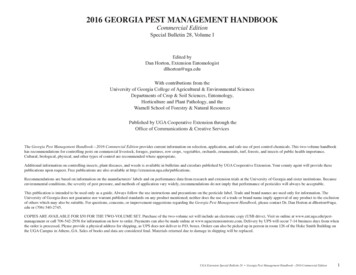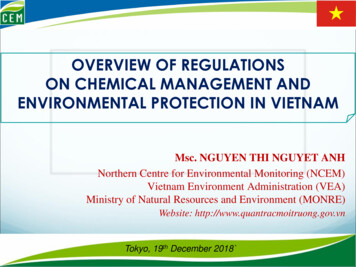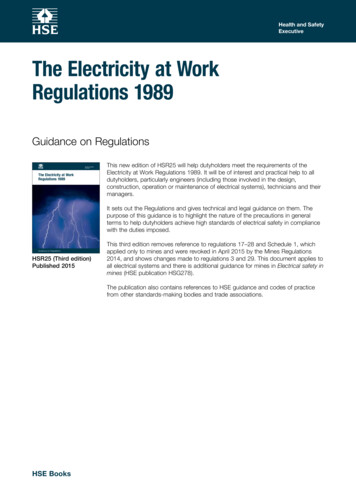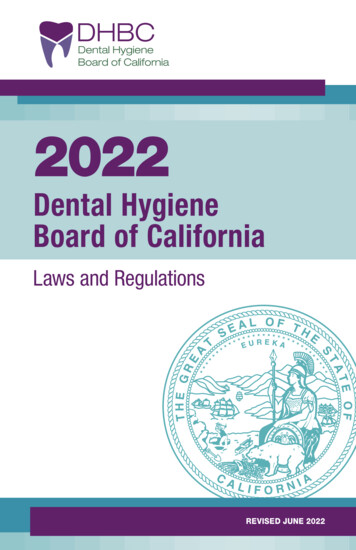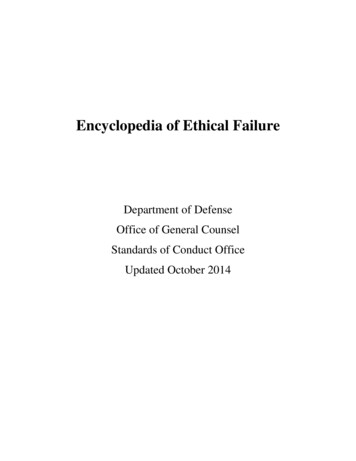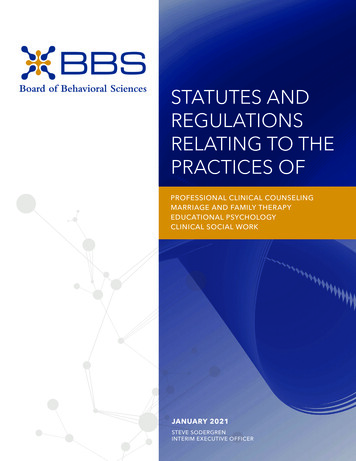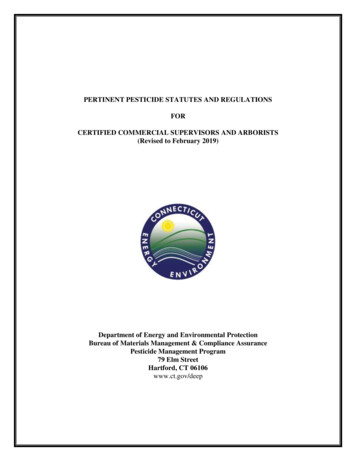
Transcription
PERTINENT PESTICIDE STATUTES AND REGULATIONSFORCERTIFIED COMMERCIAL SUPERVISORS AND ARBORISTS(Revised to February 2019)Department of Energy and Environmental ProtectionBureau of Materials Management & Compliance AssurancePesticide Management Program79 Elm StreetHartford, CT 06106www.ct.gov/deep
INTRODUCTIONThis informational booklet contains pertinent excerpts from the General Statutes of Connecticut andRegulations of Connecticut State Agencies of relevance to commercial supervisory pesticide applicators andarborists. It contains the revisions of the General Statutes of Connecticut as of the 2009 Legislative Session andis current up to the date of publication of this booklet.The Pesticides Management Program of the Department of Energy and Environmental Protection (DEEP)oversees the licensing of pesticide applicators and arborists, and the enforcement of the Pesticide Control Act,its statutes and regulations, as well as those statutes and regulations relating to the practice of Arboriculture.Pertinent regulations that fall under the oversight of the Pesticides Management Program are included in thisbooklet.This informational booklet includes some General Statutes that do not fall within the jurisdiction or enforcementcapability of DEEP, but nevertheless are of importance to commercial pesticide applicators. Specifically, thestatute sections regarding pesticide applications at schools and daycare facilities have been added to this edition.Individuals with questions regarding these statutes or any subsequent regulations are advised to contact theappropriate state agency.From time to time this publication may be updated by the Pesticides Management Program to include any newamendments or additions that are of importance to commercial supervisory pesticide applicators or arborists.Readers are advised to keep up to date regarding any changes in these laws, new Public Acts or regulations.The General Statutes of Connecticut may be viewed at the Connecticut State Library Web Site as found atwww.cslib.org/psaindex.htm. Copies of Regulations of Connecticut State Agencies may be obtained from thestate agency that oversees them or from the Connecticut State Library.DEEP is an affirmative action/equal opportunity employer, providing programs and services in a fair andimpartial manner. In conformance with the Americans with Disabilities Act, DEEP makes every effort toprovide equally effective services for persons with disabilities. Individuals with disabilities needing auxiliaryaids or services, or for more information by voice or TTY/TDD call (860) 424-3000.2
TABLE OF CONTENTSConnecticut General StatutesSectionTitlePagePA 18-84***New*** An act prohibiting the use of automatic pesticide misting machinesTITLE 10Chapter 170Boards of EducationSec. 10-231a.Pesticide applications at schools: Definitions.6Sec. 10-231b.Pesticide applications at schools: Authorized applicators. Exception.6Sec. 10-231c.Pesticide applications at schools without an integrated pest management plan.7Sec. 10-231d.Pesticide applications at schools with an integrated pest management plan.8Sec. 448Pesticide applications on municipal playgrounds.9TITLE 19aChapter 368aDepartment of Public HealthSec. 19a-77.(Formerly Sec. 19-43b). "Child day care services" defined. Additional license.10Sec. 19a-79a.Pesticide applications at day care facilities.11TITLE 22Chapter 422Department of AgricultureSec. 22-11a.Integrated pest management defined.11Sec. 22-11b.Duties of the University of Connecticut Cooperative Extension Servicere integrated pest management.11Chapter 426Agriculture Experiment StationSec 22-84a.Research consistent with goals of integrated pest management.TITLE 22aChapter 441Pesticide ControlSec. 22a-46.Short title: Connecticut Pesticide Control Act.12Sec. 22a-47.Definitions.12Sec. 22a-50***New*** Reclassification of neonicotinoids14Sec. 22a-54.Pesticide applicators, certification, classification, notice, fees, reciprocity;financial responsibility; aircraft, tree, public employee applicators.14Sec. 22a-58.Records to be kept by distributors and applicators.15Sec. 22a-59.Enforcement; inspection, samples, warrants.15Sec. 22a-61.Prohibited acts. Certification refusal, revocation; grounds; hearing.16Sec. 22a-61a***New*** Prohibition re neonicotioid applications on linden or basswood trees.173(Effective 10/1/2015)612
Sec 22a-61b***New*** Prohibition re application of neonicotinoids when plantbears blossoms. Excpetions.18Sec. 22a-63.Penalties; fine, imprisonment. Agents.18Sec. 22a-66a.Notification of the application of pesticides. Registry. Regulations. Penalty.18Sec. 22a-66b.Pesticide application businesses: Definitions. Compliance with record maintenancerequirements.20Sec. 22a-66c.Registration of pesticide application businesses. Application. Fee.20Sec. 22a-66d.Action by the commissioner.21Sec. 22a-66e.Grounds for denial.21Sec. 22a-66f.Employment of commercial supervisory pesticide applicator.22Sec. 22a-66g.Records. Availability.22Sec. 22a-66h.Penalties.22Sec. 22a-66i.Action of officer or agent deemed to be action of pesticide application business.22Sec. 22a-66j.Regulations.22Sec. 22a-66k.Utilities pesticide management plan. Notice of application.22Sec. 22a-66l.Application of pesticides by state agencies. Review by Commissioner ofEnvironmental Protection. Model integrated pest management plans.23Sec. 22a-66z.Permit for use of pesticides in state waters. (Formerly Sec. 19-300u)23TITLE 23Chapter 451Public Shade Trees and Tree Protection Examining BoardSec. 23-61a.Definitions. Tree Protection Examining Board. Regulations.24Sec. 23-61b.Licensing for arboriculture; examination; fees; renewal; suspension;revocation. Nonresidents. Records. Pesticides.24Sec. 23-61e.Appeals.25Sec. 23-61f.Penalties; jurisdiction of violators.25Sec. 23-61g .Arborist business. Definitions.26Sec. 23-61h .Arborist business. Certificate of registration. Application. Fee.Exemption re pesticide application.26Sec. 23-61i.Issuance of certificate. Denial. Hearing. Revocation or suspension of certificate.Grounds. Reapplication.26Sec. 23-61j.Employment of arborists by arborist business.27Sec. 23-61k.Retention of records by arborist business. Information required.Inspection by commissioner. Customer records.27Sec. 23-61l .Violations. Penalty. Attorney General action.284
Sec. 23-61m.Action by officer, agent or person acting for or employed by arborist business.28REGULATIONS OF CONNECTICUT STATE AGENCIESPesticide ControlSec. 22a-54-2.Fees for certification of pesticide applicators.28Sec. 22a-65-1.Discarding of pesticides and containers.28Sec. 22a-66-1.Use of pesticides. Definitions.29Sec. 22a-66-2.Control of registrations and uses.29Sec. 22a-66-3.Application of pesticides.30Sec. 22a-66-5.Certification and licensing of applicators.30Sec. 22a-66a-1.Public notification of outdoor pesticide applications.Requirements for pesticide wholesalers, distributors, retailersNotice of pesticide applications to golf coursesNotice of pesticide applications to lakes and ponds32333334Sec. 22a-66a-2.Requests for notification of pesticide application to abutting property.35Sec. 22a-66l-1.Application of pesticides by state agencies.36Sec. 22a-66z-1.Application of chemicals to state waters.37Arborist, Tree Protection Examining BoardSec. 23-61a-1Purpose.37Sec. 23-61a-1aDefinitions.37Sec. 23-61a-2Examinations.38Sec. 23-61a-3Licenses.38Sec. 23-61a-4Renewal.38Sec. 23-61a-5Complaints and investigations.38Sec. 23-61a-6Hearings, suspension and revocations.38Sec. 23-61a-7Records and reports.39APPENDIXAExample – Outdoor pesticide application posting sign40APPENDIXBExample – Aquatic pesticide application posting sign41(Note: A break in the numbering sequence indicates that a section not pertinent to certified commercial pesticide applicators orarborists has been omitted.)5
**New**Public Act 18-84AN ACT PROHIBITING THE USE OF RESIDENTIAL AUTOMATIC PESTICIDE MISTING SYSTEMS.Sec. 22a-66n. Residential automatic pesticide misting system. Prohibition. Regulations. Fine. (a) On and afterJanuary 1, 2019, no person shall install or utilize any residential automatic pesticide misting system in this state. Forpurposes of this section, "residential automatic pesticide misting system" means any device that is designed to be installedon, near or around the exterior of any residential dwelling or the grounds of such residential dwelling and to automaticallyspray any pesticide solution at timed intervals.(b) The Commissioner of Energy and Environmental Protection may adopt regulations, in accordance with theprovisions of chapter 54, to implement the provisions of subsection (a) of this section. Such regulations may include, butshall not be limited to, the establishment of a fine for the violation of subsection (a) of this section.Connecticut General StatutesChapter 170Boards of EducationSec. 10-231a. Pesticide applications at schools: Definitions. (Effective from passage – 7/1/2015)As used in sections 10-231b to 10-231d, inclusive, as amended by this act, (1) "pesticide" means a fungicide used onplants, an insecticide, a herbicide or a rodenticide, but does not mean a sanitizer, disinfectant, antimicrobial agent orpesticide bait, (2) "lawn care pesticide" means a pesticide registered by the United States Environmental Protection Agencyand labeled pursuant to the federal Insecticide, Fungicide and Rodenticide Act for use in lawn, garden and ornamental sitesor areas. "Lawn care pesticide" does not include (A) a microbial pesticide or biochemical pesticide that is registered withthe United States Environmental Protection Agency, (B) a horticultural soap or oil that is registered with the United StatesEnvironmental Protection Agency and does not contain any synthetic pesticide or synergist, or (C) a pesticide classified bythe United States Environmental Protection Agency as an exempt material pursuant to 40 CFR 152.25, as amended fromtime to time, (3) "integrated pest management" means use of all available pest control techniques, including judicious useof pesticides, when warranted, to maintain a pest population at or below an acceptable level, while decreasing the use ofpesticides, (4) "microbial pesticide" means a pesticide that consists of a microorganism as the active ingredient, and (5)"biochemical pesticide" means a naturally occurring substance that controls pests by nontoxic mechanisms.Sec. 10-231b. Pesticide applications at schools: Authorized applicators. Exception. (Effective July 1, 2009)(a) No person, other than a pesticide applicator with supervisory certification under section 22a-54 or a pesticide applicatorwith operational certification under section 22a-54 under the direct supervision of a supervisory pesticide applicator, mayapply pesticide within any building or on the grounds of any school, other than a regional vocational agriculture center.This section shall not apply in the case of an emergency application of pesticide to eliminate an immediate threat to humanhealth where it is impractical to obtain the services of any such applicator provided such emergency application does notinvolve a restricted use pesticide, as defined in section 22a-47.(b) No person shall apply a lawn care pesticide on the grounds of any public or private preschool or public or private schoolwith students in grade eight or lower, except that (1) on and after January 1, 2006, until July 1, 2010, an application of alawn care pesticide may be made at a public or private school with students in grade eight or lower on the playing fieldsand playgrounds of such school pursuant to an integrated pest management plan, which plan (A) shall be consistent withthe model pest control management plan developed by the Commissioner of Environmental Protection pursuant to section22a-66l, and (B) may be developed by a local or regional board of education for all public schools under its control, and (2)an emergency application of a lawn care pesticide may be made to eliminate a threat to human health, as determined by thelocal health director, the Commissioner of Public Health, the Commissioner of Environmental Protection or, in the case of apublic school, the school superintendent.6
Sec. 10-231c. Pesticide applications at schools without an integrated pest management plan. (Effective 10/1/2015)(a) As used in this section, "local or regional board of education" means a local or regional board of education that does nothave an integrated pest management plan for the schools under its control that is consistent with an applicable model planprovided by the Commissioner of Environmental Protection under section 22a-66l and "school" means a school, other thana regional vocational agriculture center, under the control of a local or regional board of education.(b) On and after July 1, 2000, at the beginning of each school year, each local or regional board of education shall providethe staff of each school and the parents or guardians of each child enrolled in each school with a written statement of theboard's policy on pesticide application on school property and a description of any pesticide applications made at the schoolduring the previous school year. Such statement and description shall be provided to the parents or guardian of any childwho transfers to a school during the school year. Such statement shall (1) indicate that the staff, parents or guardians mayregister for prior notice of pesticide applications at the school, and (2) describe the emergency notification proceduresprovided for in this section. Notice of any modification to the pesticide application policy shall be sent to any person whoregisters for notice under this section.(c) (1) On and after July 1, 2000, parents or guardians of children in any school and school staff may register for priornotice of pesticide application at their school. Each school shall maintain a registry of persons requesting such notice. Priorto providing for any application of pesticide within any building or on the grounds of any school, the local or regionalboard of education shall provide for the transmittal of notice, by electronic mail, to parents and guardians who haveregistered for prior notice under this section such that such electronic mail notice is received no later than twenty-four hoursprior to such application. Notice shall be given by any means practicable to school staff who have registered for suchnotice. Notice under this subsection shall include (A) the name of the active ingredient of the pesticide being applied, (B)the target pest, (C) the location of the application on the school property, (D) the date of the application, and (E) the nameof the school administrator, or a designee, who may be contacted for further information.(2) On and after October 1, 2015, prior to providing for any application of pesticide within any building or on the groundsof any school, in addition to the requirements of subdivision (1) of this subsection, the local or regional board of educationshall provide for notice of such application not less than twenty-four hours prior to such application by posting the noticerequired by subdivision (1) of this subsection either on or through: (A) The home page of the Internet web site for theschool where such application will occur, or, in the event such school does not have a web site, on the home page of theInternet web site for such local or regional board of education, and (B) the primary social media account of such school orlocal or regional board of education. Each local or regional board of education shall indicate on the home page of suchboard of education how parents may register for prior notice of pesticide applications, as described in subdivision (1) of thissubsection. Not later than March fifteenth of each year, the local or regional board of education shall send through theelectronic mail notification or alert system or service of such school or local or regional board of education the noticerequired by subdivision (1) of this subsection for applications made since January first of such year and a listing of suchnotices for applications made during the March fifteenth through December thirty-first timeframe from the precedingcalendar year. The local or regional board of education shall additionally print such electronic mail notification required bythis subdivision in the applicable parent handbook or manual, provided nothing in this subdivision shall be construed torequire the reprinting of such handbook or manual to provide such notification. Nothing in this subdivision shall require thedevelopment or use of an Internet web site, social media account or electronic mail notification or alert system that is notalready in use or existence prior to the effective date of this section. For purposes of this section and section 10-231d, asamended by this act, "social media" means an electronic medium where users may create and view user-generated content,such as uploaded or downloaded videos or still photographs, blogs, video blogs, podcasts or instant messages.(d) On and after July 1, 2000, no application of pesticide may be made in any building or on the grounds of any schoolduring regular school hours or during planned activities at any school except that an emergency application may be made toeliminate an immediate threat to human health if (1) it is necessary to make the application during such a period, and (2)such emergency application does not involve a restricted use pesticide, as defined in section 22a-47. No child may enter anarea where such application has been made until it is safe to do so according to the provisions on the pesticide label.(e) On and after July 1, 2000, a local or regional board of education may make an emergency application of pesticidewithout prior notice under this section in the event of an immediate threat to human health provided the board provides fornotice, by any means practicable, on or before the day that the application is to take place to any person who has requestedprior notice under this section and concomitantly provides such notice in accordance with subdivision (2) of subsection (c)of this section.7
(f) A copy of the record of each pesticide application at a school shall be maintained at the school for a period of five years.Such record shall include the information required under section 22a-66a.Sec. 10-231d. Pesticide applications at schools with an integrated pest management plan. (Effective 10/1/2015)(a) As used in this section, "local or regional board of education" means a local or regional board of education which has anintegrated pest management plan for the schools under its control that is consistent with an applicable model plan providedby the Commissioner of Environmental Protection under section 22a-66l and "school" means a school, other than a regionalvocational agriculture center, under the control of a local or regional board of education.(b) On and after July 1, 2000, at the beginning of each school year, each local or regional board of education shall providethe staff of each school with written guidelines on how the integrated pest management plan is to be implemented and shallprovide the parents or guardians of each child enrolled in each school with a statement that shall include a summary of theintegrated pest management plan for the school. Such statement shall be provided to the parents or guardian of any childwho transfers to a school during the school year. Such statement shall (1) indicate that the staff, parents or guardians mayregister for notice of pesticide applications at the school, and (2) describe the emergency notification procedures providedfor in this section. Notice of any modification to the integrated pest management plan shall be sent to any person whoregisters for notice under this section.(c) On and after July 1, 2000, parents or guardians of children in any school and school staff may register for notice ofpesticide application at their school. Each school shall maintain a registry of persons requesting such notice. Notice underthis subsection shall include (1) the name of the active ingredient of the pesticide being applied, (2) the target pest, (3) thelocation of the application on the school property, (4) the date of the application, and (5) the name of the schooladministrator, or a designee, who may be contacted for further information.(d) (1) On and after July 1, 2000, a local or regional board of education shall provide notice, by any means practicable, toany person who has requested notice under this section on or before the day that any application of pesticide is to take placeat a school. No application of pesticide may be made in any building or on the grounds of any school during regular schoolhours or during planned activities at any school except that an emergency application may be made to eliminate animmediate threat to human health if [(1)] (A) it is necessary to make the application during such a period, and [(2)] (B)such emergency application does not involve a restricted use pesticide, as defined in section 22a-47. No child may enter anarea of such application until it is safe to do so according to the provisions on the pesticide label.(2) On and after October 1, 2015, prior to providing for any application of pesticide within any building or on the groundsof any school, in addition to the requirements of subdivision (1) of this subsection, the local or regional board of educationshall provide for notice of such application not less than twenty-four hours prior to such application by posting the noticerequired by subdivision (1) of this subsection either on or through: (A) The home page of the Internet web site for theschool where such application will occur, or, in the event such school does not have a web site, on the home page of theInternet web site for such local or regional board of education, and (B) the primary social media account of such school orlocal or regional board of education. Each local or regional board of education shall indicate on the home page of suchboard of education how parents may register for prior notice of pesticide applications, as described in subdivision (1) of thissubsection. Not later than March fifteenth of each year, the local or regional board of education shall send through theelectronic mail notification or alert system or service of such school or local or regional board of education the noticerequired by subdivision (1) of this subsection for applications made since January first of such year and a listing of suchnotices for applications made during the March fifteenth through December thirty-first timeframe from the precedingcalendar year. The local or regional board of education shall additionally print such electronic mail notification required bythis subdivision in the applicable parent handbook or manual, provided nothing in this subdivision shall be construed torequire the reprinting of such handbook or manual to provide such notification. Nothing in this subdivision shall require thedevelopment or use of an Internet web site, social media account or electronic mail notification or alert system that is notalready in use or existence prior to the effective date of this section. For purposes of this section and section 10-231d, asamended by this act, "social media" means an electronic medium where users may create and view user-generated content,such as uploaded or downloaded videos or still photographs, blogs, video blogs, podcasts or instant messages.(e) A copy of the record of each pesticide application at a school shall be maintained at the school for a period of five years.Such record shall include the information required under section 22a-66a.8
Sec. 448. (NEW) (Effective October 1, 2015) (a) As used in this section:(1) "Pesticide" means a fungicide used on plants, an insecticide, a herbicide or a rodenticide but does not mean a sanitizer,disinfectant, antimicrobial agent or a pesticide bait;(2) "Microbial pesticide" means a pesticide that consists of a microorganism as the active ingredient;(3) "Biochemical pesticide" means a naturally occurring substance that controls pests by nontoxic mechanisms;(4) "Lawn care pesticide" means a pesticide registered by the United States Environmental Protection Agency and labeledpursuant to the federal Insecticide, Fungicide and Rodenticide Act for use in lawn, garden and ornamental sites or areas."Lawn care pesticide" does not include (A) a microbial pesticide or biochemical pesticide that is registered with the UnitedStates Environmental Protection Agency, (B) a horticultural soap or oil that is registered with the United StatesEnvironmental Protection Agency and does not contain any synthetic pesticide or synergist, or (C) a pesticide classified bythe United States Environmental Protection Agency as an exempt material pursuant to 40 CFR 152.25, as amended fromtime to time;(5) "Certified pesticide applicator" means a pesticide applicator with (A) supervisory certification under section 22a-54 ofthe general statutes, or (B) operational certification under section 22a-54 of the general statutes, who operates under thedirect supervision of a pesticide applicator with such supervisory certification;(6) "Controlling authority" means the executive head of the municipal department responsible for the maintenance of aplayground or such person's designee. "Controlling authority" does not include the executive head of any municipaldepartment responsible for the maintenance of any school;(7) "Municipal playground" means an outdoor area owned or controlled by any town, city or borough, consolidated townand city or consolidated town and borough that is designated, dedicated and customarily used for playing by children, suchas any such outdoor area that contains any swing set, slide, climbing structure, playset or device or object upon whichchildren play. "Municipal playground" does not include any: (A) Playground located on the premises of any school, or (B)athletic field; and(8) "Athletic field" means any field or open space used primarily for sporting activities.(b) No person other than a certified pesticide applicator shall apply pesticide within any municipal playground except aperson other than a certified pesticide applicator may make an emergency application of pesticide to eliminate animmediate threat to human health, including, but not limited to, the elimination of mosquitoes, ticks and stinging insects,provided (1) the controlling authority determines such emergency application of pesticide to be necessary, (2) thecontrolling authority deems it impractical to obtain the services of a certified pesticide applicator, and (3) such emergencyapplication of pesticide does not involve a restricted use pesticide, as defined in section 22a-47 of the general statutes.(c) No person shall apply a lawn care pesticide on the grounds of any municipal playground, except an emergencyapplication of pesticide may be made to eliminate an immediate threat to human health, including, but not limited to, theelimination of mosquitoes, ticks and stinging insects, provided (1) the controlling authority determines such emergencyapplication of pesticide to be necessary, and (2) such emergency application of pesticide does not involve a restricted usepesticide, as defined in section 22a-47 of the general statutes.(d) Prior to providing for any application of pesticide on the grounds of any municipal playground, the controlling authorityshall, if the situation permits, within the existing budgetary resources available to the controlling authority, provide publicnotice of such application not later than twenty-four hours prior to such application of pesticide. Such public notice shall beposted on the Internet web site of the applicable municipality. If a controlling authority determines an emergencyapplication of pesticide to be necessary pursuant to subsection (b) or (c) of this section, such notice shall be given as soonas practicable. Notice under this subsection shall include (1) the name of the active ingredient of the pesticide beingapplied, (2) the target pest, (3) the location of the application of pesticide on the grounds of the municipal playground, and(4) the date or proposed date of the application of pesticide. A copy of each notice of such application of pesticide at amunicipal playground shall be maintained by the controlling authority for a period of five years from the date of applicationof the pesticide and available to members of the public.9
Chapter 368aDepartment of Public HealthSec. 19a-77. (Formerly Sec. 19-43b). "Child day care services" defined. Additional license. (a) As used in sections19a-77 to 19a-80, inclusive, and 19a-82 to 19a-87, inclusive, "child day care services" shall include:(1) A "child day care center" which offers or provides a program of supplementary care to more than twelve related orunrelated children outside their own homes on a regular basis;(2) A "group day care home" which offers or provides a program of supplementary care to not less than seven nor morethan twelve related or unrelated children on a regular basis;(3) A "family day care home" which consists of a private family home caring for not more than six children, including theprovider's own children not in school full time, where the children are cared for not less than three nor more than twelvehours during a twenty-four-hour period and where care is given on a regularly recurring basis except that care may beprovided in excess of twelve hours but not more than seventy-two consecutive hours to accommodate a need for extendedcare or intermittent short-term overnight care. During the regular school year, a maximum of three additional children whoare in school full time, including the provider's own children, shall be permitted, except that if the provider has more thanthree children who are in school full time, all of the provider's children shall be permitted;(b) For licensing re
Sec. 19a-77. (Formerly Sec. 19-43b). "Child day care services" defined. Additional license. 10 Sec. 19a-79a. Pesticide applications at day care facilities. 11 TITLE 22 Chapter 422 Department of Agriculture Sec. 22-11a. Integrated pest management defined. 11 Sec. 22-11b. Duties of the University of Connecticut Cooperative Extension Service 11
